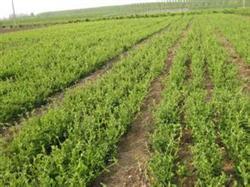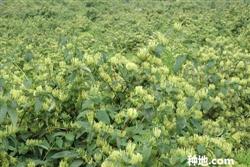Occurrence and control forecast of diseases and insect pests in Flos Lonicerae

I. Current occurrence of honeysuckle diseases and insect pests According to my station's systematic investigation on May 29: honeysuckle aphid investigation has not been found. The average rate of infected plants of red spider was 53.3%, the highest was 60.0%, the average rate of infected leaves was 15.7%, the highest was 31.3%, the average number of veneers was 31.3, the highest was 38.0, the average mite index was 4.08, the highest was 5.25, the average rate of infected plants of brown spot was 46.7%, the highest was 60.0%, the average rate of infected leaves was 7.3%, the highest was 10.0%, the average disease index was 1.92, the highest was 2.75. The average disease rate of powdery mildew was 30.0%, the highest was 40.0%, the average disease leaf rate was 3.7%, the highest was 5.0%, the average disease index was 0.92, the highest was 1.25. From April to May 2012, there were many rainy days, which was conducive to the occurrence (epidemic) of pests and diseases. At present, the occurrence and harm of pests and diseases of honeysuckle showed a rapid upward trend. II. Occurrence Trend According to the comprehensive analysis of factors such as the current occurrence of honeysuckle diseases and insect pests, future weather forecast, overall layout of honeysuckle and resistance level of varieties, farmers 'control technology, etc., it is estimated that in 2012, honeysuckle aphids will occur more frequently (grade 4), with an occurrence area of 80,000 mu times, red spiders will occur more frequently (grade 4), with an occurrence area of 80,000 mu times, powdery mildew will occur more frequently (grade 3) in general, and moderately (grade 4) in some parts, with an occurrence area of 60,000 mu times. Brown spot disease occurs moderately (grade 3), with an occurrence area of 50,000 mu times. Other diseases and insect pests occurred lightly (grade 1-2), and the occurrence area was 20,000 mu times. Third, the appropriate period of control At present, most honeysuckle plantations red spider, powdery mildew, brown spot disease and so on have reached the control index, must immediately carry out chemical control. Brown spot and powdery mildew were controlled by using medicine at the early stage of disease, and the control index was 3.0% of diseased plants. 4. Control methods 1. Agricultural control: select disease-resistant varieties, strengthen cultivation and management, reasonably plant closely, shape and prune branches, ventilate and transmit light; apply fertilizer scientifically, increase phosphorus and potassium fertilizer, improve plant disease resistance, pay special attention not to apply too much nitrogen, so as not to plant dense growth and aggravate disease degree. 2. Chemical control: Honeysuckle is a dual-purpose plant for medicine and food. Special attention must be paid to food (medicine) safety. It is forbidden to use highly toxic pesticides in production. Chemical control agents must be used under the guidance of technicians from plant protection departments and agricultural technology departments. Recommended pesticides and dosage for aphid control: 25% Pymetrozine WP 24g per mu; or 40% Pymetrozine WG 12g per mu; or 10% Imidacloprid WP 30g per mu. Recommended pesticides for controlling red spiders: 15% pyridaben emulsifiable concentrate 1000 times; or 20% ovamijing wettable powder 2500 times; or 20% abamectin wettable powder 2000 times. The recommended pesticides and dosage for controlling brown spot are: 80% thiophanate-methyl WP 100g per mu, or 70% mancozeb WP 100g per mu. The recommended pesticides and dosage for controlling powdery mildew are: 25% triadimefon WP 100g per mu or 50% hexadimefon WDG 9g per mu. Click to get more honeysuckle planting technology Click to get more herbs planting technology
- Prev

How to plant honeysuckle
Honeysuckle is a perennial tree-shaped plant, medicinal buds, cold and drought tolerance, barren hills, hills and beaches can grow. After receiving the honeysuckle seedling, untie the package immediately, dip it in the root with muddy water, improve the survival, and plant it in time. Planting method: row spacing 1.3-1.5 m, plant spacing 0.9-1 m, seedling root depth of 10 cm left.
- Next

How to cultivate honeysuckle?
How to cultivate honeysuckle? Please guide the cultivation of honeysuckle: first, cuttings are generally carried out in the rainy season. In the overcast and rainy weather in summer and autumn, choose the sturdy 1-2-year-old branches without diseases and insect pests, cut them into 30cm and 35cm long, remove the lower leaves as cuttings, and cut them as you like. On the selected land,.
Related
- Fuxing push coffee new agricultural production and marketing class: lack of small-scale processing plants
- Jujube rice field leisure farm deep ploughing Yilan for five years to create a space for organic food and play
- Nongyu Farm-A trial of organic papaya for brave women with advanced technology
- Four points for attention in the prevention and control of diseases and insect pests of edible fungi
- How to add nutrient solution to Edible Fungi
- Is there any good way to control edible fungus mites?
- Open Inoculation Technology of Edible Fungi
- Is there any clever way to use fertilizer for edible fungus in winter?
- What agents are used to kill the pathogens of edible fungi in the mushroom shed?
- Rapid drying of Edible Fungi

